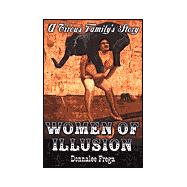
| Acknowledgments | p. ix |
| Introduction | p. 1 |
| Preparations | p. 5 |
| Initiations | p. 69 |
| Rehearsals | p. 115 |
| Showtime | p. 173 |
| Moving on | p. 239 |
| Conclusion | p. 343 |
| Notes | p. 347 |
| Bibliography | p. 349 |
| Table of Contents provided by Syndetics. All Rights Reserved. |
The New copy of this book will include any supplemental materials advertised. Please check the title of the book to determine if it should include any access cards, study guides, lab manuals, CDs, etc.
The Used, Rental and eBook copies of this book are not guaranteed to include any supplemental materials. Typically, only the book itself is included. This is true even if the title states it includes any access cards, study guides, lab manuals, CDs, etc.
Chapter One
INTRODUCTION
"Join the circus, ... Run away," sings the master of ceremonies in the closing number of a Disney "Sing-A-Long" videocassette entitled Let's Go to the Circus . In this popular children's video, a group of youngsters visit the Ringling Bros. and Barnum & Bailey Circus (conveniently unaccompanied by adults) and are temporarily transformed by a clown's magic into circus entertainers themselves. Although the children's metamorphosis is portrayed as a fantasy, the accompanying lyrics voice the timeless assumption that joining a circus represents a "straying" from home rather than a deliberate choice of a profession. This assumption has followed circuses since their earliest days, centuries ago, when acrobats and animal trainers wandered across Europe in caravans of small wagons, cooking over fires, performing in town squares, and protecting one another from villagers whose inviolable work ethic and ties to the land often caused them to view such "eccentric" nomads with mistrust or hostility.
The lure of the circus, and its myth, is its promise of an alternative to the "normal" life of adult responsibility and social obligation. The circus has long been portrayed as a world of never-ending fun, wonder, and magic; a life of constant mobility; a "family" without constraints or authority. "You'll never go home again," sings the ringmaster, echoing the irresistible calls of Peter Pan and the Pied Piper.
Running away from home has been a fantasy of every child who ever protested a chore, and literature throughout the ages teems with the adventures of Tom Sawyers and lads running off to sea. While these young protagonists are quickly matured and sobered by the difficulties of the adult worlds they encounter, children who run away to the circus are often portrayed as being trapped or frozen, like Peter Pan and the "Lost Boys" of Never-Never Land, in a clownish world of childhood from which they never can grow up. In a culture that relies on a serious, long-term commitment to land, family, and community, the circus's seductive call to "children of all ages" suggests both an escape from and an inherent threat to adult responsibility.
The attraction of the circus is grounded on its ability to undermine the accountability and apprehension that adults must usually shoulder: Dangerous beasts and potentially deadly feats of skill are presented for amusement; the disabled and unusual may be showcased willingly as "sideshow freaks," and one can stare to one's heart's content without shame or impropriety; performers entertain in the scanty, sequined costumes normally associated with strippers but the intensely sensual nature of the performance is diffused by its address to children too young to recognize sexuality beneath the glitter. Although numerous circus entertainers have been mauled, hurt, or killed over the decades while practicing or performing their acts, the illusion that they are indestructible has been carefully and proudly crafted. The process of obscuring danger is fascinating and seldom open to "outsiders," yet it can be accomplished only by drawing on the misconceptions and desires of the outside world.
My interest with the world of illusion and the people who live in it began when I met the Hubers, a family whose members have, for generations, owned circuses, performed in circuses, run away from circuses, hidden in circuses, and raised "circus children." Their stories effectively shredded my understanding of circus life as a carefree alternative to the "normal" world, revealing instead rigid distinctions, hard work, intense loyalties, and an earnest regard for perfection. They spoke of a well-developed culture where histories could be instantly erased or reinvented, nationalities and names changed at will; a way of life in which children fearlessly swing from trapezes and ride elephants but are necessarily mistrustful of the delighted children whom they entertain; a "family" as worldwide as a religion but as private as a cult.
As the Hubers have "assimilated" into the "normal" world, gravitating naturally toward the movie industry with its emphasis on spectacle, illusion, and constant change, they have had to negotiate the demands of two very different cultures and have done so with remarkable humor and creativity. I have been constantly struck by their unique discernment that all social practices and beliefs are constructs, however deeply they may be valued. In recording their stories, I have found myself questioning the boundaries of concepts that I have always taken for granted: family, childhood, history, danger, and normalcy.
My experience with the Hubers has been a rich discovery of the processes by which we learn both to accept the illusory and to question the invisible. Together, the Hubers have slowly unraveled the tightly knit blanket of mystery, silence, and constant reinvention that conceals their family history. They have revealed the passion and exuberance, cruelty and fortitude, excesses and silences that accompany life in the world of illusion.